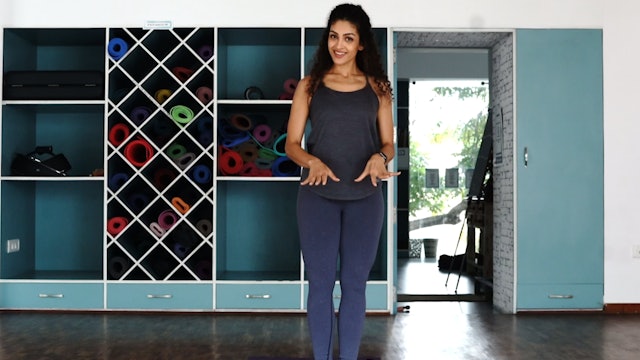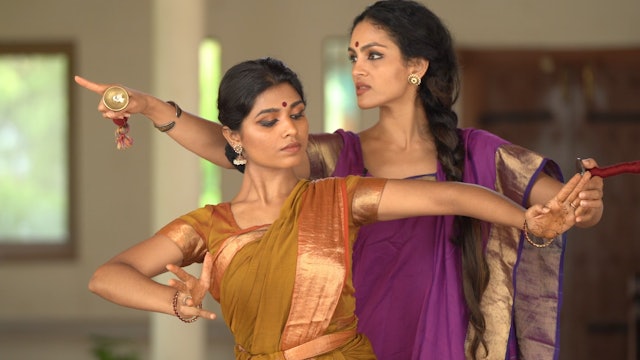Playlist 38
This playlist introduces a new core workout that is set to music. Please make sure that you feel no pain in the back when doing any of the core work and also make sure you have practised and internalised the alignment instructions from the instructed series before embarking on the musical series.
The playlist also completes Vandeham Sharadam and continues with lectures on Abhinaya, exploring in detail, Aaharya Abhinaya.
-
Warm up flow
This routine approaches your warm-up in a fun, dynamic way. It opens up your body through repetition while paying attention to alignment. You must have been practising all the instructed warm-ups prior to this alongside the first few strength routines in order to follow with ease.
-
Obliques, flat backs and legs
This introduces the flat back and builds muscles in the back. It is recommended that you do this sequence after you lengthen your hamstrings to prevent your back from curving. It also introduces a lowering action on your quadriceps which will help build stronger legs.
The flexibility series tha...
-
Musical Series: Core B
This sequence of exercises reinforces ideas that have already been introduced in the previous instructed series for the Core muscles/ Obliques. It is recommended to start on the musical series only once you have practised the instructed series over several months, so you already have internal awa...
-
Jumps in Parallel
This series will deal with a number of short exercises that will help the student develop awareness and alignment when jumping. It must be done in combination with the strength exercises to have maximum benefit.
Please do not do the jumps if you experience knee pain.
You must be warmed up befo... -
Turned out Jumps
Please do this jump only after doing all the previous jumps in this series. It must be done in combination with the strength exercises to have maximum benefit.
Please commence this exercise only after doing hip openers, warming up your ankles, and doing some balance work with the standing and li...
-
Skip jumps
This series will deal with a number of short exercises that will help the student develop awareness and alignment when jumping. It must be done in combination with the strength exercises to have maximum benefit.
Please commence this exercise only after, warming up your ankles, and doing some bal...
-
Horse jump prep
This series will deal with a number of short exercises that will help the student develop awareness and alignment when jumping. It must be done in combination with the strength exercises to have maximum benefit.
The horse jump prep, introduces a jump in parallel where the legs use the udvahitam ...
-
Cat jump prep
This series will deal with a number of short exercises that will help the student develop awareness and alignment when jumping. It must be done in combination with the strength exercises to have maximum benefit.
Please commence this exercise only after doing hip openers, warming up your ankles, ...
-
Cat jump
Please do this jump only after doing all the previous jumps in this series. It must be done in combination with the strength exercises to have maximum benefit.
Please commence this exercise only after doing hip openers, warming up your ankles, and doing some balance work with the standing and li...
-
Turning horse jump
Please do this jump only after doing all the previous jumps in this series. It must be done in combination with the strength exercises to have maximum benefit.
Please commence this exercise only after warming up your ankles, and doing some balance work with the standing and lifted leg turned ou...
-
Paraval adavu
The Paraval adavu moves to the side, like the Pakkadavu, but the srea covered is expansive. The articulation of the feet changes. There are many varieties in this adavu. Although Paraval serves as an umbrella classification, sometimes we call the adavus by varied names based on how the feet inter...
-
Paraval Adavu 1
Paraval literally means to spread. Some schools of thought also call the Paraval adavu, the 'Pakkadavu' as it moves to the side while sliding. Some others change the name based on the way the foot articulates with the floor. A few of the types of Paraval, can be referred to as Marditam adavau, as...
-
Paraval Adavu 2
Paraval literally means to spread. Some schools of thought also call the Paraval adavu, the 'Pakkadavu' as it moves to the side while sliding. Some others change the name based on the way the foot articulates with the floor. A few of the types of Paraval, can be referred to as Marditam adavau, as...
-
Parval Adavu 3
Paraval literally means to spread. Some schools of thought also call the Paraval adavu, the 'Pakkadavu' as it moves to the side while sliding. Some others change the name based on the way the foot articulates with the floor. A few of the types of Paraval, can be referred to as Marditam adavau, as...
-
'Ta hata jumtari ta' Adavu: Instructions
The "Ta hata jumtari ta" Adavu, is named after the syllables that are used in the practice of the Adavu. This practise is common amongst most lineages of Bharatanatyam.
The Adavu is a combination of various movements. It has the 'di, di tai" action with the Tattu and Naatu, from the Muktaya ada...
-
Ta hata Jumtari ta Adavu
The "Ta hata jumtari ta" Adavu, is named after the syllables that are used in the practice of the Adavu. This practise is common amongst most lineages of Bharatanatyam.
The Adavu is a combination of various movements. It has the 'di, di tai" action with the Tattu and Naatu, from the muktaya ada...
-
Kuditta Mettadvau
As mentioned in the Tattu mettaduvu, 'mettu' is a movement that comprises of a heel drop. Kuditta Mettaduvu or Yegar Mettaduvu, has a small jump onto the balls of the feet and then a drop of the heels. This Adavu is varied primarily with arm and torso movements. It is one of the only Adavus that ...
-
Kuditta Mettaduvu
Pointers for Kuditta Mettadavu:
Try to go down instead of hopping up each time you snatch onto your heels.
Keep dropping your tailbone and pushing your thighs back.
When you bend to the side, try not to have any form of a forward bend.By the time you progress to the Kuditta mettadavu, your l...
-
Kuditta Mettadavu: Variations
The Kuditta mettadavu, named so because of the combination of a small jump and then the dropping of the heel, is usually done with hands to the side and then a small cross at the wrists.
These variations, continue with the same movement of the feet while changing the torso and arm movements.
-... -
Vandeham Sharadam: Part 4
Raga: Yamuna Kalyani
Mishra Chapu
Composer: Swami Dayananda Saraswati
Choreography: Rukmini Vijayakumar
Language: SanskritIt describes Goddess Saraswati, the embodiment of knowledge, speaking of how the knowledge of the self is revealed to those who have clarity of thought, and unselfish intent...
-
Vandeham Sharadam
Vandeham Sharadam
Raga: Yamuna Kalyani
Mishra Chapu
Composer: Swami Dayananda Saraswati
Choreography: Rukmini Vijayakumar
Language: SanskritIt describes Goddess Saraswati, the embodiment of knowledge, speaking of how the knowledge of the self is revealed to those who have clarity of thought, a...
-
Expression Series 7: Āhārya Abhinaya
The four means or tools of expression and communication that we use on stage are , Āngika, Vāchika, Āharya and Sātvika Abhinayas. These lectures will delve into each of these and explain them in detail.























